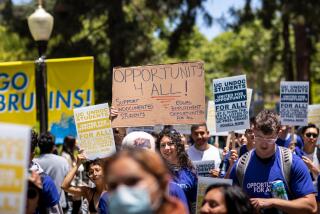The hidden battle over California’s new vaccine law
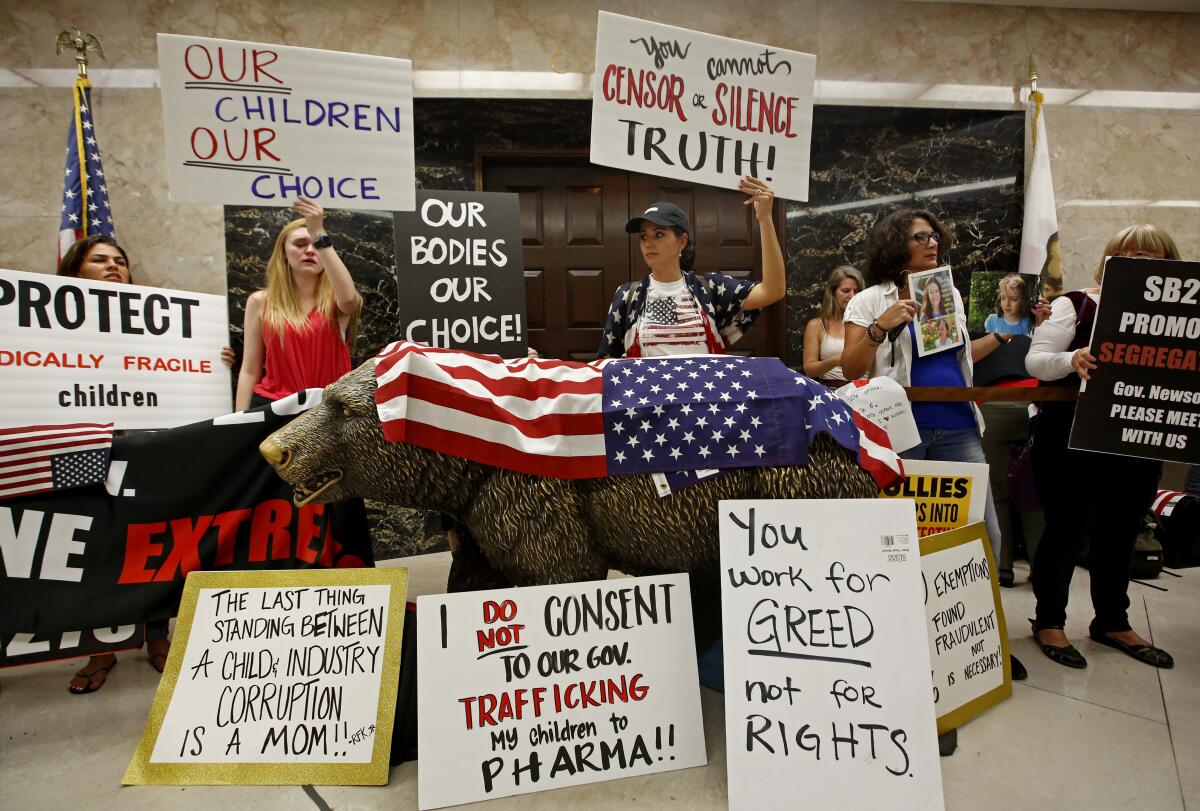
SACRAMENTO — Most everyone who heard Gov. Gavin Newsom’s words had the same reaction: He’s finally on board.
After two frenetic weeks spent rewriting a high-profile plan requiring more California schoolchildren to be vaccinated, making changes to Newsom’s specifications, legislators and advocacy groups breathed a sigh of relief on June 18 when reporters asked the governor about his support for the proposal.
“All those amendments, if they’re made, stamp of approval,” Newsom said.
But 78 days later, hours before a crucial legislative vote, the governor’s advisors abruptly told lawmakers he wanted more changes — and they were substantial.
Of the more than 2,600 bills introduced this year in the California Legislature, none captured the public’s attention like Senate Bill 276. Prompted by an alarming rise in measles cases and allegations of questionable vaccine exemptions, it was the legislative equivalent of a Rorschach test. Some were convinced they saw it as government overreach, others as a victory for science over social media-fueled skepticism. Along the way, it became a measurement of Newsom himself — the charismatic new governor who had yet to establish firm relationships with many of his fellow Democrats in the Legislature.
The Times interviewed more than two dozen people involved in the private negotiations and public debate over SB 276, including legislators, state Capitol staffers, lobbyists and advocates. Their accounts detail missteps in the governor’s office, erratic communication among decision-makers and the emergence of a devout lobby of parents as a political force in Sacramento.
Long before Newsom’s surprise decision, SB 276 had sparked a fierce debate over public health and parental rights. Lawmakers received thousands of calls and emails and were tagged in a steady flow of social media posts. The tone was often hostile, if not menacing: Several legislators were subjected to taunts and threats by those who insisted vaccines were harmful or that inoculation mandates were part of a secret plot by pharmaceutical companies and government officials.
The Democratic legislator who wrote the bill was physically accosted outside of a Sacramento restaurant. On the final night of the legislative session, a protester threw a menstrual cup filled with what the California Highway Patrol said “appeared to be blood” onto state senators from a visitor’s gallery, prompting the Senate chamber to be evacuated.
Enacting SB 276 into California law was never going to be easy. But some of those involved felt that Newsom’s evolving position over a carefully crafted bill inflamed the debate — giving hope to critics that he would block the bill and pause to supporters about the governor’s backing for what they saw as a vital issue of public health.
A new Capitol fight to boost vaccine rates
State Sen. Richard Pan (D-Sacramento), who led a 2015 fight over vaccine exemptions for schoolchildren, wasted little time after the Legislature convened this year in laying out the reason for launching a new war to increase vaccine rates.
When he introduced SB 276 in March, the Centers for Disease Control and Prevention had reported a surge in new cases of measles during the first three months of the year, bringing the total in the United States to more than 500. The pace at which the highly contagious disease was spreading worried public health experts. The number of cases nationwide had already surpassed all of those reported in 2018.
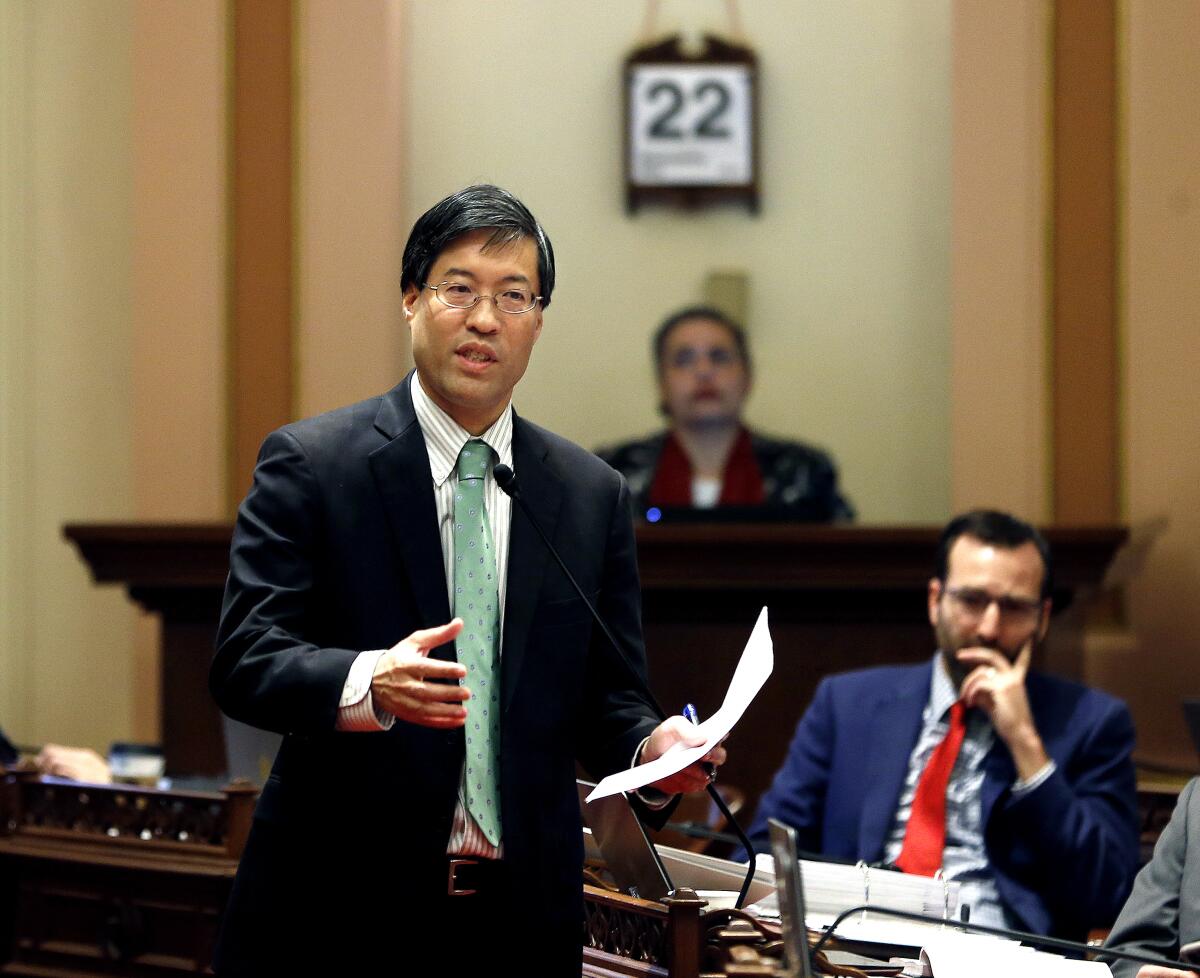
California created some of the toughest inoculation laws in the country in 2015 with Pan’s Senate Bill 277, allowing children to skip vaccines only when a doctor determines there is a medical reason to do so. But public health officials said the state’s progress was being undermined by an increasing number of questionable exemptions.
Pan and a coalition of physicians and vaccine supporters determined there was a loophole in the 2015 law, citing media reports about a handful of doctors who had written a majority of medical exemptions in the state. His staff collected online posts in which parents skeptical of vaccines discussed doctor shopping for medical exemptions.
“A few unethical physicians advertise medical exemptions for cash,” Pan said on March 25 as he unveiled his plan to combat “unscrupulous doctors.”
But even lawmakers who would go on to support his new proposal were concerned that it was too soon to impose new restrictions. Many recalled the chaos that ensued for months before then-Gov. Jerry Brown signed Pan’s first bill, banning vaccine exemptions based on personal or religious beliefs.
Few were surprised when hundreds of vaccine critics returned to Sacramento in protest. The first hearing on SB 276 in April drew hundreds — the Capitol hallways became humid from the crowds as mothers entertained children in lines that snaked around corners. Parents waited for hours to speak in front of the Senate Health Committee to voice their opposition to a bill they said would result in their children being forced out of school because the criteria for medical exemptions was too narrow.
Pan, who chaired the committee, stood expressionless as insults were hurled his way. One person called him a “tyrant” while another said his bill was a “crime against humanity.”
As SB 276 made its way through the Legislature, vaccine critics grew more vocal and the number of measles cases reported in California surged. The Legislature adopted new ways to usher crowds through congested hallways. Lawmakers denounced increasingly violent rhetoric around the bill.
The governor had offered no comment about the legislation. But that changed nine days after it was approved by the Senate.
Newsom’s surprise concern
Nothing on the June 1 agenda of the California Democratic Party’s annual convention suggested the vaccine bill would make headlines. Newsom attended to offer opening remarks.
But when a reporter asked Newsom about the bill after he left the convention stage, he cast doubt on legislation that had, until that point, enjoyed a relatively smooth ride through the lawmaking process.
“I like doctor-patient relationships. Bureaucratic relationships are more challenging for me,” he said of SB 276 and its proposed state oversight of vaccine exemptions.
“I’m a parent. I don’t want someone that the governor of California appointed to make a decision for my family.”
The comments, which came as a surprise to the bill’s advocates, caught fire with vaccine skeptics. Robert F. Kennedy Jr., who had met with Newsom almost five months earlier, quickly took to social media praising the governor for “his wise and sober opposition to a draconian proposal.”
Pan, who had been in the audience for Newsom’s speech, was shocked. He didn’t know the governor had concerns about his bill until he read them on Twitter.
“We are used to dealing with Gov. Jerry Brown, who is famously tight-lipped about pending bills,” Pan said. “So, my initial reaction was ‘Oh, he commented on my bill.’ Then it was, ‘Oh, wait, what does this mean?’”
Newspaper editorials cast Newsom’s comments as a major blunder. Sources with direct knowledge told The Times that the governor’s staff scrambled to make the negative media coverage go away.
But first they had to figure out exactly what the governor wanted, a task left to Health and Human Services Secretary Mark Ghaly, a pediatrician and the former director of health and social impact for Los Angeles County.
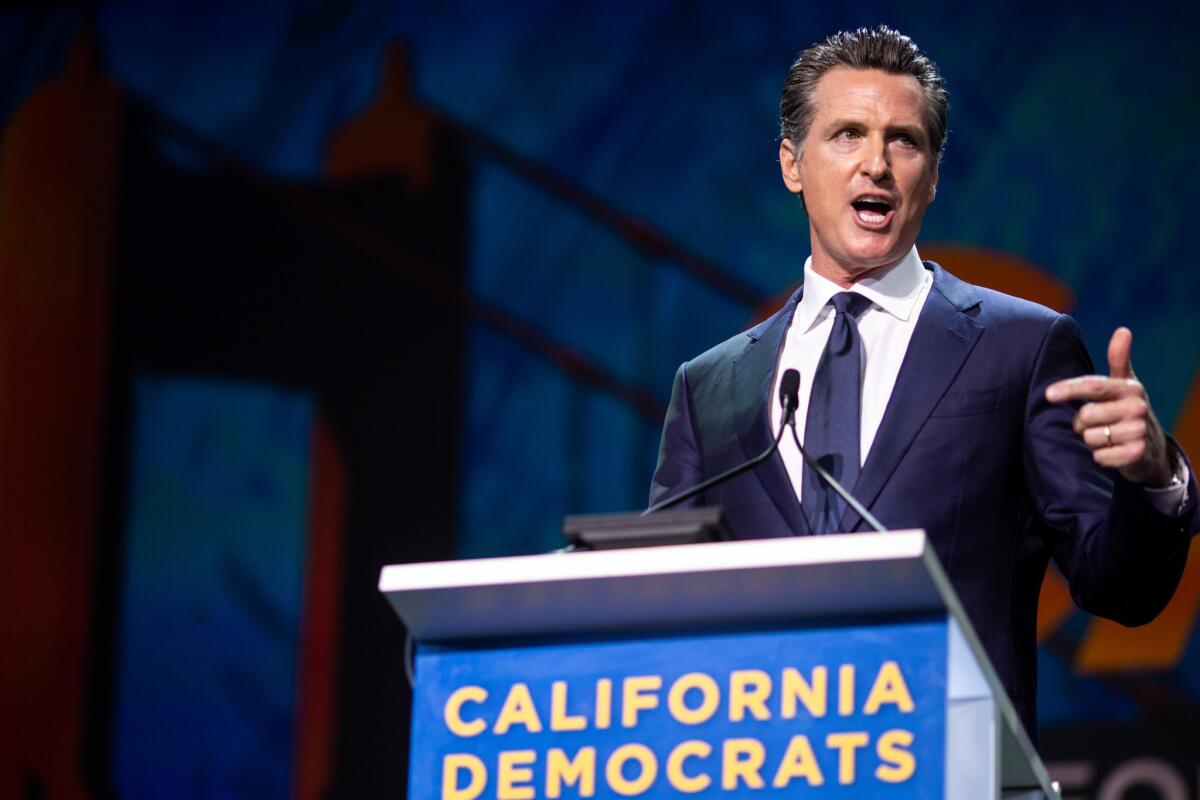
Over the next two weeks, Pan and Ghaly hammered out a deal that struck a delicate balance between addressing Newsom’s bureaucracy concerns and preserving the state‘s oversight under the bill to avoid an appearance that anti-vaccine protesters had won a major concession.
The eventual compromise — as much about policy as optics — seemed to work for both sides. Instead of the state Public Health Department reviewing all medical exemptions, officials would focus their scrutiny on schools with immunization rates below 95% and exemptions written by doctors who issue five or more waivers in a calendar year.
The threshold would allow the state to ensure that schools with low immunization rates did not pose a danger to the public. Physicians say people are best protected from measles outbreaks if at least 95% of a community is vaccinated.
A source involved in the negotiations said the threshold for doctors writing exemptions was less scientific. Most doctors write one or two medical exemptions a year, so five seemed like a good number, the source said.
And in an effort to satisfy the concerns of parents, an appeals process would be created for children whose medical exemptions are revoked by the state.
The changes also added some new teeth to SB 276 by ensuring that the Medical Board of California had access to a child’s medical records for investigations into complaints against doctors. The state public health department would also be able to prohibit a physician from writing new medical exemptions while he or she is under investigation by the medical board.
With the amendments agreed to, upbeat news releases were issued.
Pan thanked Newsom for “his leadership on children’s health and standing up for science and the importance of vaccination.” Ghaly thanked Pan for “partnering with the administration.” And after the backslapping came a pledge: Newsom would sign the bill.
“We made significant amendments, meaning a lot of progress, and worked collaboratively the last 10 days,” Newsom told The Times.
With Newsom’s approval secured, supporters of the bill turned their attention to countering online pleas and angry posts from the opposition that they felt could sway legislators’ votes.
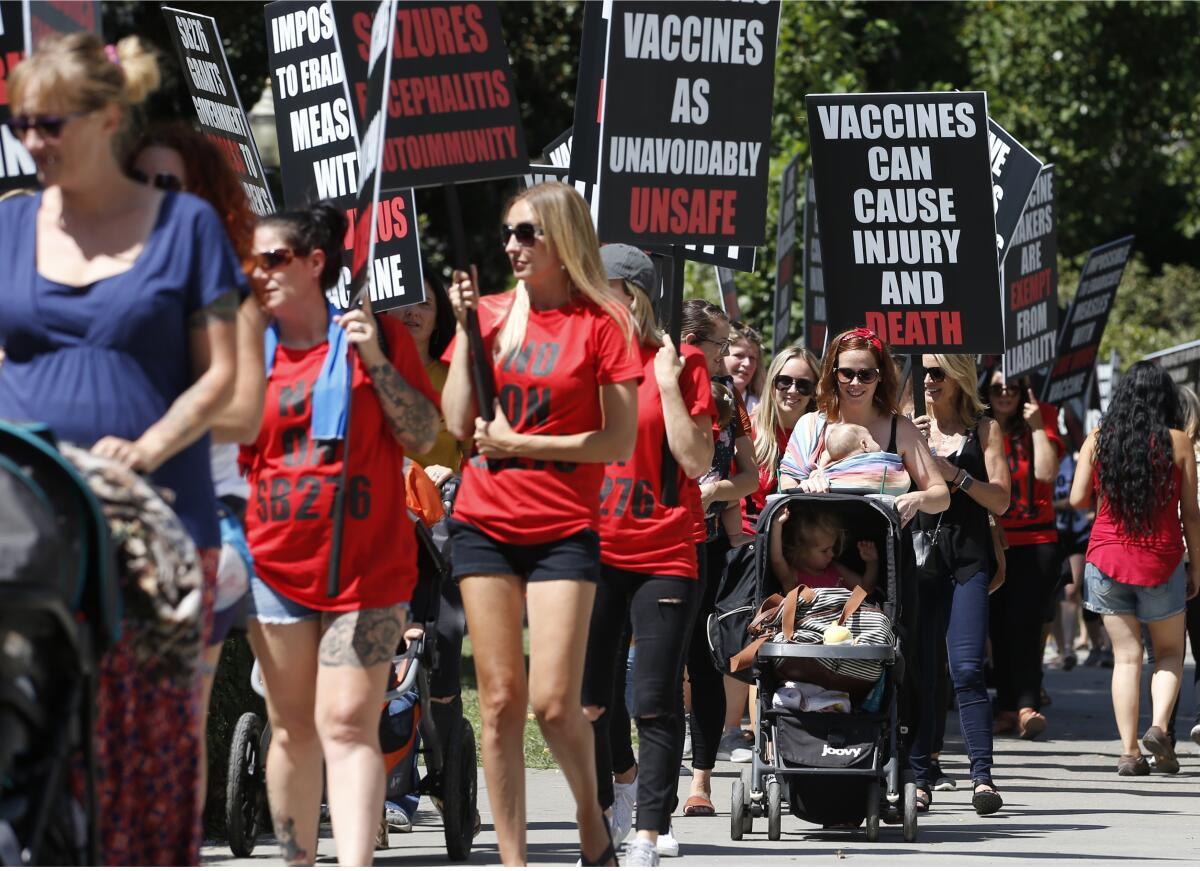
The California Medical Assn., the main sponsor of the bill, paid Republican strategist Mike Madrid to lead a social media campaign in July aimed at boosting pro-vaccination messages on social media, recruiting parents to join in.
“The goal was to change the narrative,” Madrid said. “We had to show the loud voices were a fringe movement.”
The opposition had its own plan: lobby First Partner Jennifer Siebel Newsom.
Opponents approached her at a public event and later secured a meeting with her chief of staff. Parents against the bill said they hoped that Siebel Newsom would be sympathetic to their cause. Siebel Newsom declined to comment on her involvement, while the governor would only say to reporters that “everyone has opinions.”
A deal lost
The pact with the governor fell apart in late August, and it wasn’t clear why.
Pan was notified two days before a crucial Aug. 30 vote in the Assembly Appropriations Committee that Newsom had new concerns.
Many of those interviewed by The Times said the initial amendments proposed by Newsom would have significantly limited the state’s oversight of vaccine exemptions.
For the first time, the administration wanted to set aside all existing medical exemptions from new scrutiny. The amendments also would have delayed oversight of new medical exemptions until 2021, leaving proponents fearing that a crush of parents would rush to obtain an exception for their child before the law took effect.
After marathon negotiations between Pan’s office, the administration and advocates went late into the night of Aug. 29, the outline of a new deal seemed to surface. But the next day, SB 276 was sent to the Assembly floor with no changes. Staffers who worked on the amendments were confused, and sources interviewed by The Times paint a muddy picture of what happened as the long Labor Day weekend began.
The vote and the tweet
Few in the Capitol expected a vote on SB 276 — including Pan and his co-author, Assemblywoman Lorena Gonzalez (D-San Diego) — when the Assembly took it up late on the day they returned to Sacramento after the holiday weekend. But Assembly leaders quietly planned for a quick vote that would send the bill back to the Senate for final approval before protesters amassed in the chamber’s visitors gallery.
“All of the rush was around the fact that we believed they would try to shut down the legislative session,” said John Casey, a spokesman for Assembly Speaker Anthony Rendon (D-Lakewood).
Legislators didn’t know they would be in for a second surprise.
Shortly before the vote, Newsom’s advisors implied to some in the Assembly that the governor would veto the legislation if changes weren’t made.
Assuming Newsom’s staff had similar conversations with the Senate, Assembly leaders agreed to put any amendments into a second bill. But the governor’s office had not communicated with the Senate about Newsom’s demands, several sources told The Times. And Pan, who had been left in the dark, hadn’t agreed to the changes, either.
Minutes after SB 276 cleared the Assembly on a 48-19 vote, Carrie Cornwell, chief of staff to Rendon, approached an upbeat Pan and said the governor’s amendments would probably go into a new bill.
Pan, who appeared confused and upset, told Cornwell that everyone needed to get on the same page.
“It turns out that Pan didn’t want the [second] bill and it became a stare-down between the governor and the Senate,” said a source in the Legislature who asked to remain anonymous to speak freely on the matter.
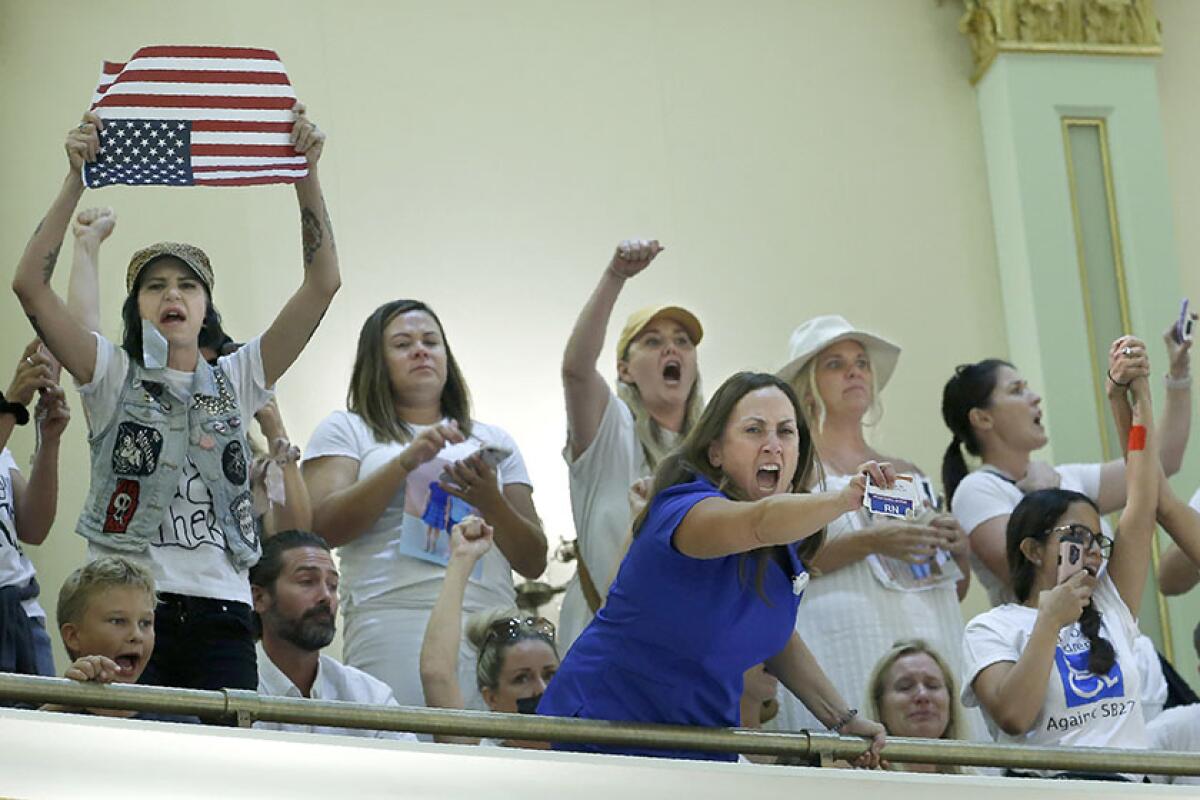
Then Newsom’s office added to the confusion with a statement on Twitter.
“There are a few pending technical — but important — changes to the bill that clarify the exemption and appeal process that have broad support,” the tweet said. “The Governor believes it’s important to make these additional changes concurrently with the bill, so medical providers, parents and public health officials can be certain of the rules of the road once the bill becomes law.”
Frustrated that the message came so late in the process and to most of the Legislature for the first time through social media, Democrats complained about Newsom and his staff in private meetings over the next several days, according to several sources.
In an interview with The Times two days later, Rendon said his house felt “blindsided.”
“Our caucus was taken by surprise by the governor’s tweet,” he said.
Some in the Assembly went so far as to compare the governor to President Trump, who routinely airs his feelings on Twitter, sources said. Others said Newsom’s actions showed a disconnect with legislators and a lack of understanding of concerns for their safety as they debated the bill.
They also questioned his absence from the negotiating table and why his office failed to communicate with Pan.
“There were so many people speaking up that it became a collective concern,” said one legislator, who declined to be identified to speak freely about the situation. “It was a disappointment.”
In the Senate, some Democrats were concerned that Newsom had gone back on his word. Others, who represent dozens of vaccine skeptics in wealthy Los Angeles enclaves, were less critical of the governor. Understanding Pan’s frustrations, they agreed to follow his lead with a second bill, SB 714, which included changes he negotiated with the governor’s office.
“We’ve done the work that we need to do,” Senate President Pro Tem Toni Atkins (D-San Diego) told The Times on Sept. 5. “I think the author of the bill, it’s really in his hands to figure out how he wants to proceed.”
Vaccine critics see a glimmer of hope
Opponents of SB 276 began hearing there was hope that Newsom was on their side.
Inside the offices of the governor and legislators, where the noisy protests could still be heard, there were hurried negotiations over what the new amendments would do. Though Newsom’s office called the potential changes “technical,” at least one was significant: The governor wanted all existing medical exemptions issued before 2020 to remain valid — with no ability to reject ones suspected of being fraudulent, according to sources directly involved in the negotiations.
Under the compromise between Pan and Newsom’s office, the state would allow all medical exemptions to remain in place until a child entered kindergarten, seventh grade or changed schools. Temporary medical exemptions would be limited to one year.
In addition, any doctors disciplined by the medical board would have all of their medical exemptions overturned beginning Jan. 1, an amendment targeting Orange County pediatrician Bob Sears, an outspoken advocate for parents skeptical of vaccines.
That change, opponents said, would put too much power in the hands of the state.
“It’s like saying let’s put the Catholic Church in charge of abortions,” said Stefanie Fetzer of the opposition group Parents United 4 Kids. “There is a bias here. The medical board and public health department want kids vaccinated.”
The anger — and an explanation from Newsom
Forty-seven minutes after the Senate ratified the follow-up bill, Newsom signed both pieces of legislation into law.
The unusual agreement about the bill signing was attributed by several sources to a lack of trust between legislators and Newsom. The governor would sign SB 276 only after final legislative approval of SB 714, but before the latter bill was officially sent to his desk. The setup would allow the Senate to withdraw SB 714 if Newsom had a last-minute change of heart.
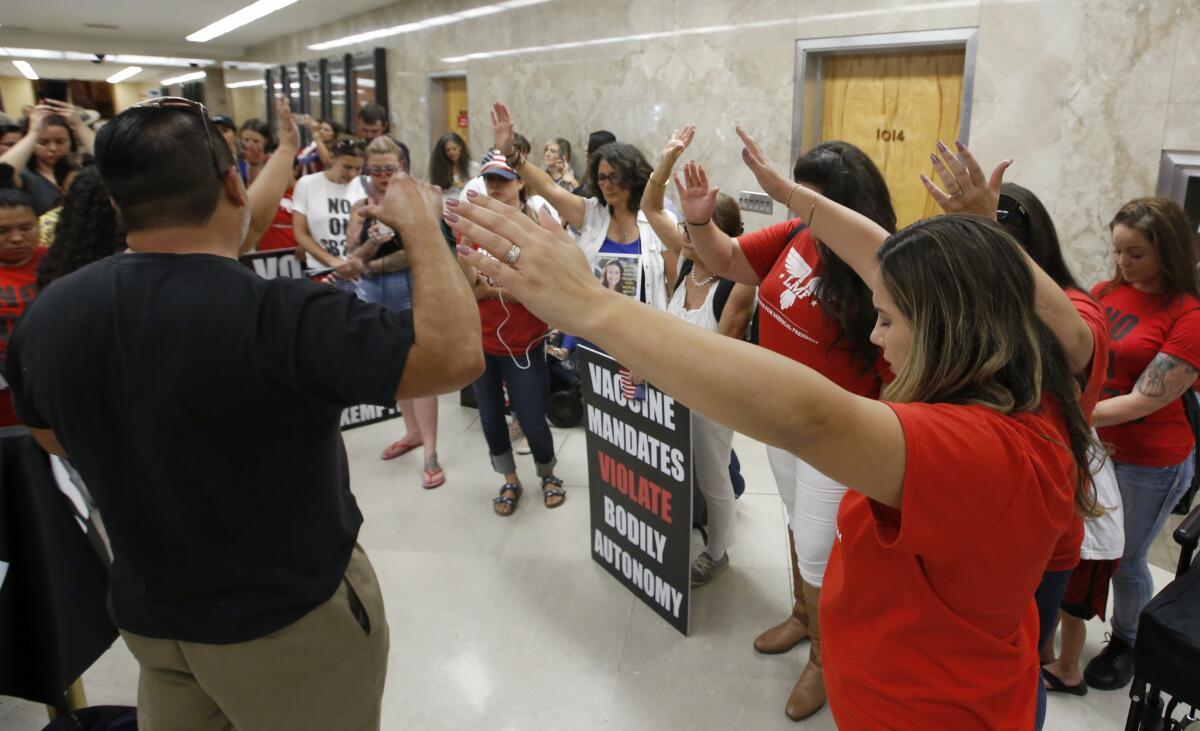
On Sept. 13, just after 5 p.m. on the final day of the session, an anti-vaccine protester hurled a menstrual cup with what appeared to be blood, splashing several lawmakers.
Three days later, in what marked the first time the governor had spoken with reporters in more than two weeks, Newsom was inundated with questions about the vaccine legislation. He sought to dispel any notion of controversy around his decision to back out of the deal and said his handling of the situation had no effect on his relationship with the Legislature.
The governor seemed irritated by the questions, including whether anyone in his family has vaccine exemptions. “Nope,” he said.
He disputed the idea that he had sown confusion over insisting on changes at the last minute.
“It’s the nature of the deliberative process,” Newsom said.
More to Read
Sign up for Essential California
The most important California stories and recommendations in your inbox every morning.
You may occasionally receive promotional content from the Los Angeles Times.


